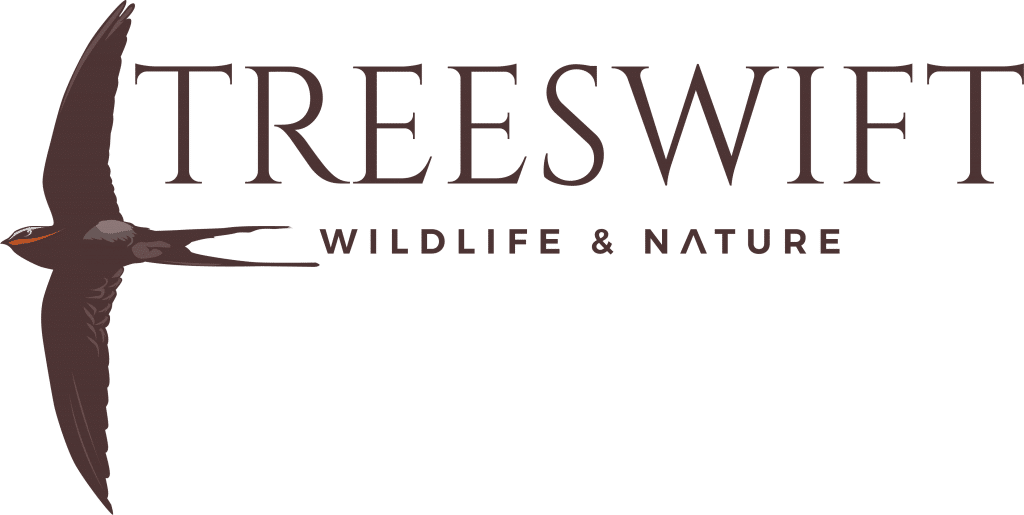Last Friday, Treeswift Wildlife & Nature led one of our Wet Forest Day Tours to the stunning Dandenong Ranges National Park located approximately 40km east of Melbourne. We were accompanied by Trương, Linh, and Phan, who were hoping to photograph some of Australia’s rainforest specialties. Today’s targets included Crimson Rosella, Gang-gang Cockatoo, Australian King Parrot, Eastern Whipbird, and the strikingly unique, Superb Lyrebird.
We arrived at midmorning to a quiet and tranquil forest of tall Mountain Ash, Mountain Grey Gum, Prickly Currant-bush, and the beautiful yet introduced, European Holly. After a quick morning coffee (and a piece of shortbread), we grabbed our cameras and descended into the surrounding gullies of Rough Tree-Fern, Giant Moss, and Stereum fungi.
It was a lovely morning for honeyeaters and other forest birds. Taking the path down into the forest, we listened to White-throated Treecreeper, Yellow-faced Honeyeater, White-naped Honeyeater, Australian Golden Whistler, and a distant Bell Miner. As the forest started to darken underneath the ever-increasing rainforest foliage, we finally heard our first target species – Eastern Whipbird. This insectivorous ground-dwelling bird is an iconic and familiar sound in rainforests across the east coast of Australia. This famous ‘whip‘ can be heard for quite a distance and is produced by the male bird. Usually you will hear a long drawn out whistle, followed by the crack of whip. This, more often than not, is immediately answered by the female whistled “choo-choo”.
Today, we were able to enjoy several close-up views as a pair of birds fed in the leaf litter and Austral Bracken. A real highlight experience because this species so rarely allows for long and clear viewing!
Further on, we watched a pair of Eastern Grey Kangaroo bound away through a clearing before stopping to admire a very photogenic Laughing Kookaburra as he hunted for skinks in the grass. The grasses were covered in a kaleidoscope of butterflies, most notably, Shouldered Brown (Heteronympha penelope). Though we did not get a clear view, the skink’s were thought to be McCoy’s Skink (Anepischetosia maccoyi) – an endemic species typically found in highlands and forest environments.
Our camera’s also received a quick work out as a pair of Yellow-tailed Black Cockatoo flew over the clearing, followed quickly by a single Sulphur-crested Cockatoo.
Despite the fact it was late summer, the forest was quite wet and very green. Because of this, there was a healthy array of forest mushroom and fungi sprouting across the forest floor. Most common were Stereum versicolor, Pixie’s Parasol, and several stunning clumps of Fairy Parachutes.
Moving further into the forest, we finally heard our main target – the Superb Lyrebird. Most people know about this species. It is internationally renowned thanks to its extraordinary mimicry and stunning tail. When performing, the males usually find a perch or small clearing. Here it begins an extraordinary song that consists of other bird calls, forest sounds, and occasionally man-made noises such as chainsaws, car horns, and engines. The result is something mystifying and remarkable. To complete this already exceptional routine, the male lowers its long decorative tail and plumes like a shimmering shower over its entire body.
Autumn is the time to see this performance and today, we were in luck. After creeping in the scrub, we were able to watch a male briefly sing and leap around its mound, it’s silvery, lacey-tail twinkling behind it. Unfortunately, this was a short performance and the bird soon spotted us. Not taking kindly to the intrusion, it scurried off into the forest.
We were however, still in luck! As back on the path, we found a lovely female scratching around in leaf-litter. And she was more than happy to pose for a number of photos.
Our Superb Lyrebird luck continued and soon, we had seen 3x different females scratching around in the undergrowth. It appeared that despite the male’s persistence, the females weren’t quite interested in mating yet. We did enjoy some great views of their tails, thought not quite as magnificent as the males, but still very beautiful!
As we continued through the forest, we had a number other great encounters such as flock of Australian King Parrot, Crescent Honeyeater, Striated Thornbill, Rufous Whistler, and another highlight photographic opportunity with Eastern Yellow Robin. There were also several flocks of Silvereye and a few brief views of the stunning Red-browed Firetail, one of Australia’s most incredible finches.
Finally on our way back east through the forest, we connected with a significant flock of Crimson Rosella. Though we had seen a few flying through the canopy, this was our first opportunity to stop, enjoy a good look, and take a few photos. The birds behave and posed brilliantly and our group were able to rattle off dozens of full-frame shots.
Returning to car, we ended our outing with a healthy 29x birds, 1x mammal, 1x reptile, 1x butterfly, a few dozen endemic plants, trees, and fungi, and a memory card or two crammed with memories. All in all, a wonderful morning! Thanks to Trương, Linh, and Phan for joining us – we hope you enjoyed the experience!



1 thought on “Sherbrooke Forest – Trip Report”
I love pixie’s parasol!